New monkey discovered in Tanzania
A NEW SPECIES OF MONKEY IS DISCOVERED IN TANZANIA: THE FIRST IN AFRICA FOR OVER 20 YEARS
WCS Release on mongabay.com
May 19, 2005
Africa’s first new species of monkey for over 20 years has been discovered in the remote mountains of southern Tanzania.
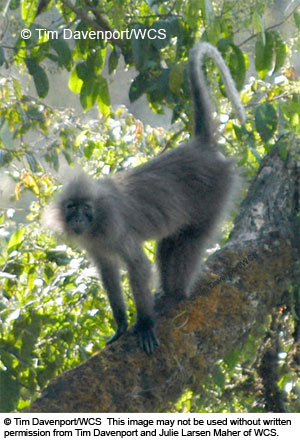 The Highland Mangabey. Photo by Dr Tim Davenport. The Highland Mangabey is the first new monkey species discovered in Africa in more than 20 years. Its natural habitat is threatened by logging, hunting and unmanaged resource extraction. If you are interested in making a contribution to help protect this new species and its unique habitat, please contact Dr. Davenport. |
|
Called the “Highland Mangabey” (Lophocebus kipunji), this long-haired forest primate was first discovered by conservation biologists from the Wildlife Conservation Society (WCS) on the flanks of the 2961 m (10,000 ft) volcano Mt. Rungwe and in the adjoining Kitulo National Park. Remarkably, this highly secretive animal was later also found by another team working independently more than 350 km (230 miles) away. The discovery is described in the leading journal Science.
“This discovery proves that there is still much to learn about the more remote and less well-known areas of Tanzania, and Africa as a whole”, said Dr Tim Davenport who directs the WCS Southern Highlands Conservation Program, and who led the team of Noah Mpunga, Sophy Machaga and Dr Daniela De Luca who found the monkey. “Having been so involved in the creation of the Park and the conservation of Mt. Rungwe, it has been very exciting for us to help reveal more of their secrets. The real challenge now though, is to try and conserve them,” he added.
The new arboreal mangabey is brown, with a head and body length of about 90 cm (3 ft). The monkey occurs as high as 2450 m (8,000 ft) in Kitulo and on Mt Rungwe, where temperatures often fall below freezing; its long coat is probably an adaptation to the cold. The taxonomic name of the species, Lophocebus kipunji, recognizes the monkey’s local
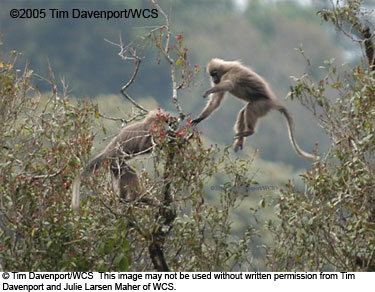 The Highland Mangabey. Photo by Dr Tim Davenport. |
|
Kinyakyusa name (pronounced kip-oon-jee) used by a handful of hunters around Mt. Rungwe. Indeed, the monkey has long been known by the hunters who climb into the mountains to hunt. However, these days it seems that only the older generation are aware of the animal. The Highland Mangabey is extremely rare and critically endangered, with an estimated total population of between 500 and 1,000 animals. According to Davenport the Southern Highland forests, including those of Mt. Rungwe and Kitulo, are highly degraded by illegal logging, and without prompt action the animal’s future is uncertain.
So how was the monkey discovered? It was during interviews with hunters in early 2003 in villages around Mt Rungwe, that Mpunga first heard rumours about a shy monkey known as Kipunji.
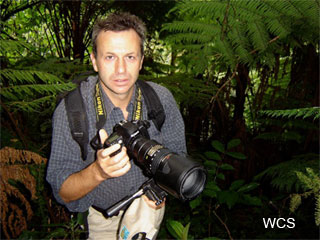 Dr Tim Davenport |
|
Davenport and Mpunga assumed at first that this was the Sykes monkey or one of the many spirit animals that are so much a part of Wanyakyusa culture. However, along with Machaga and De Luca, they began to investigate further, both in the villages at the foot of the mountains, and in the forest above. Finally, they first saw an unusual monkey in May 2003, but because of the terrain, thick secondary forest and the animal’s highly cryptic nature, subsequent sightings were infrequent and poor. It was not until December 2003, during work in the contiguous Livingstone Forest (now part of the new Kitulo National Park), that the team clearly observed the monkey at closer quarters, and Davenport recognized it as a new species of mangabey.
Eight months later in July 2004, the same species was also found in Ndundulu Forest in the Udzungwa Mountains by biologist Trevor Jones, while working on a research project for the University of Georgia’s Dr Carolyn Ehardt. The project was part-funded by a grant from the WCS Research Fellowship Program. Jones was later joined in Ndundulu by Ehardt and Conservation International (CI)’s Dr Tom Butynski. The two separate teams learned of each other’s work in October 2004 and joined forces to write the description in Science.
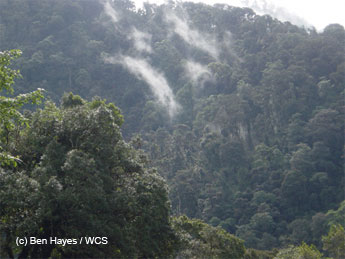 Highland Mangabey habitat. Montane forest of the Livingstones and Mt Rungwe. Photo: Ben Hayes / WCS. |
|
It is noteworthy that Mpunga and Machaga – senior conservation biologists with the WCS Southern Highlands Conservation Program – are the first Africans to describe a species of African monkey. “We hope that this discovery will further highlight the conservation importance of the Southern Highlands and Tanzania,” said Mpunga. “As well as encourage more Tanzanians to get actively involved in conservation,” added Machaga.
The Highland Mangabey is characterized by a long, erect crest of hair on its head, elongated cheek whiskers, an off-white belly and tail, and an unusual call termed a honk-bark’ by Davenport. Indeed, it was this unique call – recorded in Rungwe-Livinsgtone by the WCS team – which definitively established the mangabey as a new species.
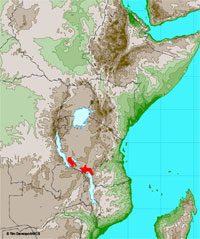 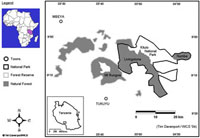 Map of Rungwe-Livinsgtone region. |
|
The monkey is known to occur in about 70 km2 of Rungwe-Livingstone in montane forest from 1750-2450m. It also occurs in about 3 km2 of Ndundulu in submontane forest from 1300-1750m. In Rungwe-Livingstone, the WCS team has so far identified 10 groups and just three groups are known from Ndundulu.
The threats to the Highland Mangabey are considerable. Logging, hunting and unmanaged resource extraction are common in the Rungwe-Livingstone forests. The narrow forest corridors linking Mt Rungwe to Livingstone, and joining the northern and southern sections of Livingstone are all degraded. Without intervention these forests will be fragmented, resulting in isolated subpopulations of the mangabey. Indeed, the easternmost animals are probably already isolated.
Saving Highland Mangabey habitat: the WCS Kipunji Fund
In order to help protect the critically endangered’ Highland Mangabey, the Wildlife Conservation Society has set up the WCS Kipunji Fund. For more information on how you can support this work, please contact ![]() or
or ![]() . You can also contribute through this link.
. You can also contribute through this link.
The WCS Southern Highlands Conservation Program
The Southern Highlands Conservation Program (SHCP) was started by WCS in 2000 to conserve important upland habitats and species across southwest Tanzania. The Highlands lie between Lakes Nyasa/Malawi and Tanganyika on the junction of the eastern and western arms of the Great Rift Valley. Sites of particular interest are plateau grasslands, montane forests and crater lakes including Kitulo Plateau, Mt Rungwe, Livingstone Mts, Mbisi, Mporoto and Mbeya Range.
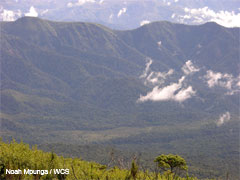 The Livingstone escarpment within Kitulo National Park viewed from the summit of Mt Rungwe. Photo: Noah Mpunga / WCS 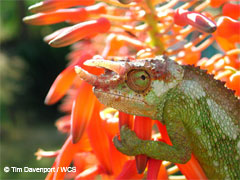 The Poroto Three-horned Chameleon (Chamaeleo fuelleborni) is one of the rarest chameleons on the continent, globally restricted to just four sites in Tanzania’s Southern Highlands. Reaching a length of 22 cm, the males of this arboreal species are highly territorial, using their horns to fight for females. They give birth to as many as 15 live young (Photo (c) Tim Davenport / WCS) 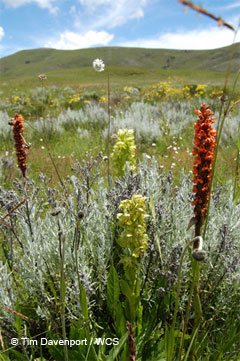 Bustani ya Mungu – God’s garden. Satyrium and Habenaria orchids on Kitulo Plateau. Photo: Tim Davenport / WCS |
|
With a staff of 20, the SHCP carries out a variety of research, protected area management support, and community conservation initiatives. Successes include bringing the international trade in orchids to light, involvement in the gazettement of Kitulo Plateau as a new and innovative national park, and comprehensive biodiversity and socio-economic surveys of Mt Rungwe, Kitulo and other unexplored areas. An environmental education component reaches thousands of people targeting schools and village environment committees. The SHCP provides support to District and Regional Governments as well as Tanzania National Parks. Indigenous tree nurseries have been developed in Rungwe, Sumbawanga and Mbeya, and over 150,000 seedlings have been raised and planted. The Program also works with local NGOs in tourism development, awareness raising, fuel efficiency and capacity building. The unique flora and fauna of the Southern Highlands are being characterised through biodiversity surveys of plants, mammals, birds, reptiles, amphibians, fish and invertebrates. The endemic and highly endangered Abbott’s Duiker is the focus of a novel conservation strategy targeting hunters, and the distribution, threats and status of all carnivore species are being monitored. Ecological research of important habitats are identifying the key threats to them. Furthermore, in-depth socio-economic studies are helping to determine natural resource use by communities across the region.
The WCS Southern Rift Program
The Southern Rift Program is a new regional initiative building on current WCS projects including the Southern Highlands Conservation Program (SHCP) in Tanzania and the Mt Mulanje Biodiversity & Monitoring Project in southern Malawi. Conservation work in the Mozambique Mts and the Nyika National Park in northern Malawi are being planned. Regarded biologically as globally outstanding’, the Southern (or Nyasa) Rift begins at the junction of the Eastern and Western (Albertine) Rifts in southwest Tanzania. It extends southward through Malawi and central Mozambique.
Through the management of these projects and the development of additional ones, the Southern Rift Program aims to assist in the conservation of important habitats and species across the region.
You can learn more about the Highland Mangabey and the WCS Southern Highlands Conservation Program at kipunji.org and the Wildlife Conservation Society at wcs.org.
You can help protect the Highland Mangabey and its unique habitat, by contacting Dr. Davenport or using this link.
Dr. Davenport has granted mongabay.com the use of these pictures. You will need to contact him about running these pictures on other sites.